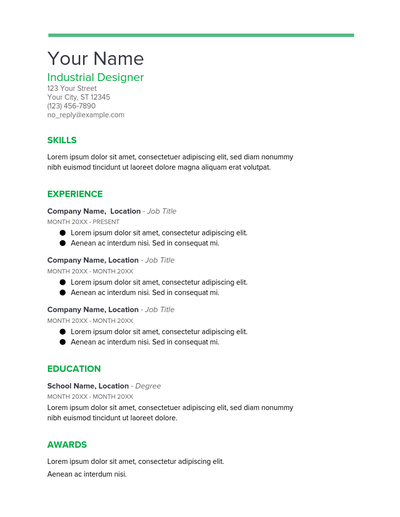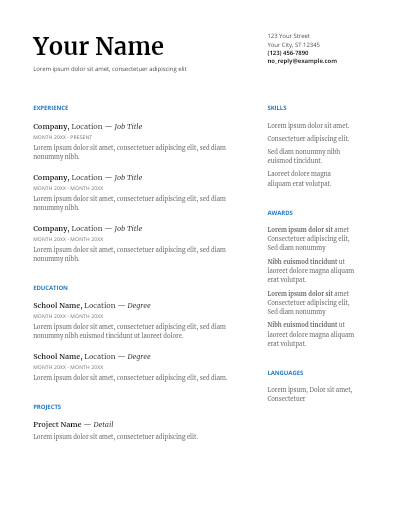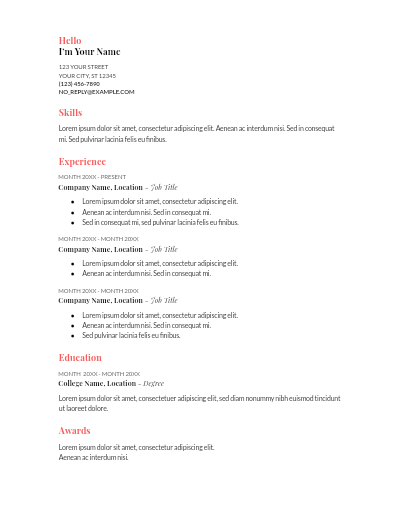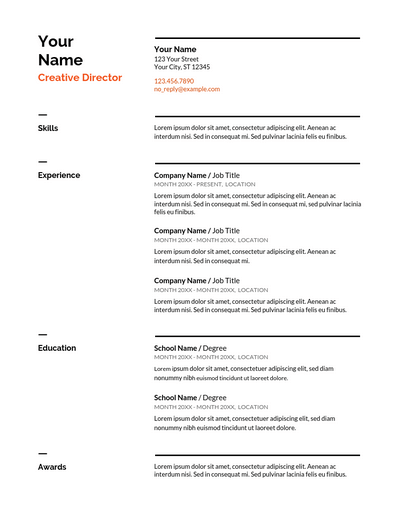Learning how to make your resume stand to get noticed by a potential employer during a job search is extremely important to land your dream job. In fact, getting a recruiter’s attention takes more than just stating your prior employment experiences.
How do you make your resume stand out?
To make your resume stand out, you’ll need to have an effective resume layout with clear sections, leverage your use of effective bullets with strong action verbs and results, and tailor it to a job posting.
MatchBuilt asked Lori Wade, a journalist, and human resource expert that covers recruiting and employee productivity, for best practices that job seekers can implement to stand out and attract attention to their resumes.
Like making your LinkedIn profile and cover letter stand out, you’ll want to ensure your resume is easy to skim and highlights your relevant experience to showcase why you’re the best candidate. You’ll also find that utilizing critical keywords in the optimization process will help you stand out. In this post, Lori details how to make your resume stand out and other vital pieces of information that will help you secure your next job.
20 Tips to Create a Resume That Stands Out
Creating a resume that stands out among 100s or even 1000s of other candidates can be difficult. These tips below are worth your consideration as you create a resume that stands out and gets noticed by recruiters and HR managers.
1. Plan Your Resume Layout With Clear Sections
The first step and one of the best ways to stand out with your resume is to maintain a clear and easy-to-skim format and design. An easy way to achieve this is to arrange the information in clear sections with your name, email, address, and LinkedIn link at the top of your resume, followed by a section on your work experience and education with any academic honors.
It has been observed that using F and E resume layout patterns is a way to capture the employer’s attention. This is because these patterns imitate how the eyes scan through internet pages. You can use these patterns in place of the right-to-left or drop-down pattern.
Primary Resume Sections
- Contact Information
- Professional Experience
- Education
- Skills
Optional Resume Sections
- Awards and Honors
- Volunteer Work
- Certifications and Licenses
- Projects
- Hobbies and interests
- Qualifications
- Extracurricular Activities
- Accomplishments
- Associations
- Publications
- Languages
- Training
- Conferences
Optional Skills Sections
- Personal Skills
- Management Skills
- Technical Skills
- Computer Skills
- Additional Skills
Pro Tip: Choose unique resume sections that best reflect the professional skills and accomplishments that match up with the job description and company.
Do Not: Add every possible resume section to your resume.
2. Don’t Be Afraid To Go Bold, Use All-Caps, and Underline
Keep your font style simple by using Calibri, Times New Roman, or Arial, but explore different font sizes and thicknesses to draw attention to the resume’s vital areas (years of experience, job title, customer service accomplishments, volunteer work, work history).
Consider bolding your name, address, job titles, companies you’ve worked for, dates employed, and section headers. You can also leverage all-caps and underline some elements.
Leading career site, FreshGigs, recommends the following as a rule of thumb regarding fonts, caps, italicizing, and underlining.
- Use font sizes 10, 11, or 12. If you wish to emphasize headings and titles, you may use font size 14 or 16.
- Use no more than two different font sizes in your resume.
- Use bold fonts sparingly to highlight key items such as the names of companies, job titles, or degrees. Some people use bold fonts to highlight key skills and qualifications, and that’s fine. Remember those bold fonts are only used to draw the reader’s attention to certain areas; no more than 10 percent of your resume should be bolded.
- Use italicized fonts only if you refer to the names of books or magazines (presumably containing work you’ve authored).
3. Crush Your Bullet Points
Long paragraphs slow down a potential employer as they scan numerous resumes for a job opening. One way to improve readability is by adding bullet points under a job or section that break up the text and make it easy to skim through. Utilizing sub-bullet points can also be effective when showcasing specific projects and accomplishments.
You want the recruiter to take note of the essential skills you have to give you a chance at the job. Therefore, you can display your skills and qualifications in bullet points to make them easy to spot. Doing that also ensures that whoever is reading your resume does not miss the critical sections of the resume.
Leveraging bullet points in critical sections, including under skills and jobs, is essential. Here are a few example bullet points to help your resume stand out. Not their use of action verbs and results.
Example Bullet Points that Attract Attention
- Sourced, hired, and developed 14 new team members in 2022
- Collaborated with three hiring managers across two different teams to aid in hiring and recruiting efforts, including writing and managing online job postings, screening candidate resumes, and conducting first-round interviews
- Spearheaded employee benefit overhaul, identifying a new, improved health insurance provider while reducing employee insurance costs by 15%
- Achieved over 90% of sales quota in Fiscal Year 2022
- Achieved 12% territory growth in Q4 2021 for the Indiana branch
- Responsible for driving $1M revenue and market share in Florida
- Led and managed a team of 3 Senior Account Managers, including recruiting, hiring, and training new reps on the company sales process
- Forecasted $8 MM across accounts and product line categories by analyzing trends, inventory, and order history
- Devised a co-forecasting process with clients which uncovered issues in their analytical system and merged client forecasts with ours
- Collaborated with sales and marketing departments to improve forecast accuracy, thus reducing the production of extra or outdated products
- Created a 7-year business plan and investor marketing materials leading to a successful $2.5MM round of financing
- Designed and implemented a company-wide loyalty rewards program for a leading Swiss retail bank with revenue exceeding $1.3BN, resulting in a 10% rise in product cross-sales
- Defined strategic vision statement for the largest gas processing firm in the Middle East, gaining board approval
- Introduced a new document management system, which improved document searchability and saved admin staff an average of 1 hour per day
- Gained buy-in from directors for the purchase of new rota management software to improve team efficiency
- Successfully reduced worker’s compensation injuries from 20 to 2 in a one-year period through the introduction of a comprehensive employee incentive program.
- Brought the organization back into federal compliance by establishing an organization-wide Leave of Absence process.
- Received corporate-wide Employee of the Year Award (pool of 100+ staff) and multiple Employee of the Month Awards (pool of 80 staff).
Other essential details to include in this section are your core and soft skills, such as how you are a team player, and make sure to present them orderly. Consider your specialty and include relevant skills. For example, one of your relevant skills would be design and communication if you’re in the creative field. If your specialty is in information and communication technology, a relevant skill may be software programming.
4. Leverage Action Words
Using action verbs throughout your resume will suggest that you’re a person of action and getting things done.
Example Action Words to Make Your Resume Stand Out
- Ambitious: Is having or showing a strong desire and determination to succeed
- Avid learner: This shows that you are very eager or enthusiastic and willing to learn
- Career-focused: Verifies that you are focused on moving forward in your career path
- Results-driven: This means that you always seek to provide the best results
- Collaborative learner: This shows that you like to work with other people to solve problems, complete tasks, or learn new concepts
- Leadership: Demonstrates your ability to lead a group of people or an organization
- Career-focused: Suggests that you are conscious of your career and the choices that affect it
- Ambitious: Is having or showing a strong desire and determination to succeed
- Flexibility: This shows that you have the willingness to change or compromise when necessary
- Integrity: Indicates that you only submit finished work that meets your high standards
- Communication: This shows your ability to share your ideas effectively with clients, coworkers, and managers
- Responsibility: Demonstrates that you can act independently and make decisions without authorization
- Adaptability: This indicates that you can adjust to new conditions.
- Motivation: Involves your ability to keep yourself motivated, along with those around you
- Focus: Shows your level of attention to tasks
- Time management: Shows your skills in developing timelines and completing projects
- Problem-solving: Demonstrates how you evaluate situations and find practical solutions
- Teamwork: Indicates you work well with others and thrive in a team environment
- Commitment to excellence: Illustrates that you are someone who strives to do their best
- Career-focused: Verifies that you are focused on moving forward in your career path
5. Tweak Critical Keywords to Beat the ATS
Because recruiters and employers have so many job seekers to choose from every time a new position gets listed online, competition is fierce, and companies need a way of filtering out the best applicants before human eyes can land on them. That’s why many businesses today use an applicant tracking system. An ATS is very beneficial to large companies but also something that can leave well-rounded candidates out of the running if they’re unprepared.
In today’s job market, similar to LinkedIn profile optimization, a job seeker’s resume needs to be optimized for an ATS, the job application, and the job description with the right keywords. This can also help you stand the chance of getting hired whether or not your recruiter uses resume parsing software such as Affinda. This software is designed to assess and extract relevant information from resumes for a specific position that is available.
Furthermore, don’t stuff your resume with too many keywords, and remember that certain software can also pick up grammatical errors. Also, avoid word repetition so your tone doesn’t sound like a bot. Instead, use human-reasoning keywords like compliance, marketing deliverables, and corporate communications in natural ways.
6. Show How You Make an Impact
Employers want to see the impact you’ve made in your previous positions.
Be specific about the impact you had in your role, how you did it, and what you accomplished, and start your bullet points or statements with strong action verbs.
Next, provide contextual details to inform the reader about your work’s purpose, the project’s scope, and what you produced or accomplished. Quantify your work and achievements where possible.
7. Tailor It to the Target Company and Job Description
Make sure to tailor the information to the company’s interests, such as your professional experience. The same applies to the job description. To do this, relate the very vital aspects of the job description to the notable parts of your resume. This is particular to your past work experiences and skills.
Let the bullet points made under every past job on the resume be as significant as possible. This is essential because the employment history on your resume is one of the initial areas an employer looks at.
8. Research Your Target Company
Identifying your target company helps to simplify your research and direct your writing to what matters. Moreover, you can easily address its needs and solutions with the right information about the company. Once you understand the company’s core competencies, for example, a best practice for your resume is to incorporate them on lists, headlines, and your resume‘s body.
Remember that you want to keep your resume concise and not too wordy. Don’t just pile on a list of skills and competencies, especially if you’re a seasoned executive. Be mindful of this as well, and keep your resume to one page. Most experienced professionals can address many of these points in their resume‘s body or qualifications section.
9. Know the Challenges the Company is Facing
When creating your resume, be sure to identify the company’s challenges. Afterward, outline your past encounters with similar challenges, how you dealt with them, and the results you got.
10. Show How You Will Add Value
Concentrate on relevant accomplishments to your target company. This will show them how you will add value as a team member.
You can do this by defining “success” in your previous positions, making a list of ways you have achieved success, quantifying that success, listing awards you’ve received, using value-related keywords, and highlighting your achievements.
11. Utilize a Resume Template That Stands Out
Pick a resume layout that stands out, remains appealing to employers in your industry, and is easy to skim. One way you can do this is by using the latest resume templates below. You might need to compare your final result with a professional standard to confirm your progress. To do this, you’ll need comparison software such as Draftable that allows you to weigh the quality of your resume.
Below are resume examples and templates that stand out for your use. Simply click on the image to view the Google doc resume. From there, you can save the resume as any type of document you’d like (Google Docs, Word, etc.). You can also save it as another Google doc to begin editing.
To quickly find examples and resumes on Google Docs, launch the Google Docs app (create an account if you haven’t already). Then, click on “Template Gallery” from the home page and scroll down until you find the resume templates. Pick a template and start editing.
Excellent for entry-level resumes, each Google Doc resume example that stands out is easy to navigate and minimalistic. Most of the templates are ideal for both recent graduates and seasoned pros.
You can easily add or replace any section you wish. So, if you’re unhappy about the skills section being so high up, replace it with a professional summary or a career objective.
Google Doc “Spearmint” Resume Example Template to Get Noticed
Google Doc “Serif” Resume Example Template that Looks Good
Google Doc “Coral” Resume Example Template that Looks Professional
Google Doc “Swiss” Resume Example Template to Stands Out
Google Doc “Modern Writer” Resume Example Template that Attracts Attention
12. Be Clear That You’re the Right Person for the Job and Prove You’re the Most Qualified
Use data when possible to display how your past accomplishments are pertinent to the job you are applying for. Use as many facts, figures, and numbers as you can in your bullet points.
How many people were impacted by your work? By what percentage did you exceed your goals? By quantifying your accomplishments, you allow the hiring manager to picture the level of work or responsibility needed to achieve this accomplishment.
13. Proofread and Have Someone Else Review Too
Carry out proper proofreading and editing before submitting your resume.
Proofreading Your Resume Tips and Tricks
- Think like an employer as you write your resume, and remember that you’re not writing it for yourself
- Edit out the unnecessary fluff
- Print it out to review
- Read it, line by line and word by word
- Read it out loud to someone
- Read it backward
- Spellcheck with an online app like Grammarly
- Have someone else proofread it
14. Consider Including a Passport-Sized Photograph
Consider adding passport-sized photographs is gradually becoming the order of sorts for many firms. This is because the applicants might not be available the first time the company assesses their files. They’ll need to see pictures of the applicants to know what they look like. Remember that adding a photo is an industry-specific recommendation, not for every job or employer. Use your best judgment here.
15. No Experience? Do This…
Not every university graduate has the experience certain companies might require. If you’re faced with such a situation, here’s what you can do:
State Your Best Qualities As Regards the Job Position
You must identify what makes you good enough for the job and project it to the employers. Outline these qualities, whether or not they’re professional.
Start Your Resume with a Personal Summary
Your personal summary is a piece of brief information about yourself. It’s important to keep this section short and straight to the point. Begin by introducing yourself and stating your educational qualification. You can follow these up with your skills or talents.
Translate Extra-Curricular Activities as Jobs
The fact that you didn’t receive any pay for past activities doesn’t imply that you didn’t gain knowledge. Include those volunteer positions and make them appear as jobs are done. Also, add the duration, date of the tasks, and the skills learned at the time.
Talk About A Project You Carried Out Upon Graduation
A good way to transfer your skills to your resume is through your degree projects. You can include your research skills in your resume if you have written a thesis. If you performed oral presentations, that’s an excellent place to draw pitching experience. Reflect on major degree activities and translate them to skills and experiences.
16. Keep it Neat and Brief
You may not be able to see your resume from the hiring manager’s viewpoint. However, one common thing amongst them is the simplicity of writing. So, you might need to keep it as simple and short as possible.
17. Add a Relevant Link
Adding a link to your profile might be necessary when applying online, as social media platforms quickly become the center for recruiters and job seekers.
Some examples of the social media platforms used by hiring managers include Facebook, Twitter, Instagram, and LinkedIn. Also, if you own a blog or website, including the links to your resume would be a plus.
18. Brand Yourself on Your Resume and Social
Make yourself stand out by sending a clear message on your resume and social profiles.
- Strive for consistency across social platforms (usernames, headshots, etc.)
- Include your resume summary on your social profiles (especially on LinkedIn)
- Share content that people in your target industry might find valuable.
19. Save and Send as a PDF Document, Now Word
If you are emailing your resume, send a PDF rather than a Word document. This will ensure all your careful formatting won’t get messed up when the hiring manager opens it.
20. Sift Through Dated and Unnecessary Jargon
An average human nowadays has an extremely low attention span. This suggests that a three-page resume would seem overwhelmingly long. A busy employer will quickly move on to a briefer document and may miss out on your excellent qualifications.
A great resume-building tip is to remove the following fluff or dated items from your resume.
- An objective or skills section at the top of your resume
- Weird or potentially polarizing interests
- Third-person voice
- An email address from your current employer or an outdated one from Yahoo or Hotmail
- Unnecessarily big words
- Tiny, unimportant jobs from 20 years ago
- Lies
Final Notes on Creating a Resume That Stands Out and Gets Noticed
Resuming writing patterns change with time, making it necessary to know the latest tips to make your resume stand out and garner attention.
To make your resume stand out, you’ll need to plan your resume layout with clear sections, leverage your use of effective bullets with strong action verbs and results, and tailor it to a job posting.
Like making your LinkedIn profile and cover letter stand out, you’ll want to ensure your resume is easy to skim and highlights your relevant experience to showcase why you’re the best candidate.
You’ll also find that utilizing critical keywords in the optimization process will help you stand out. In this post, we’ll detail how to make your resume stand out and other vital pieces of information that will help you secure your next job.









